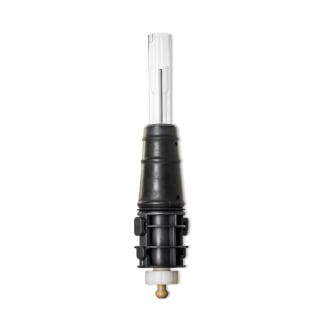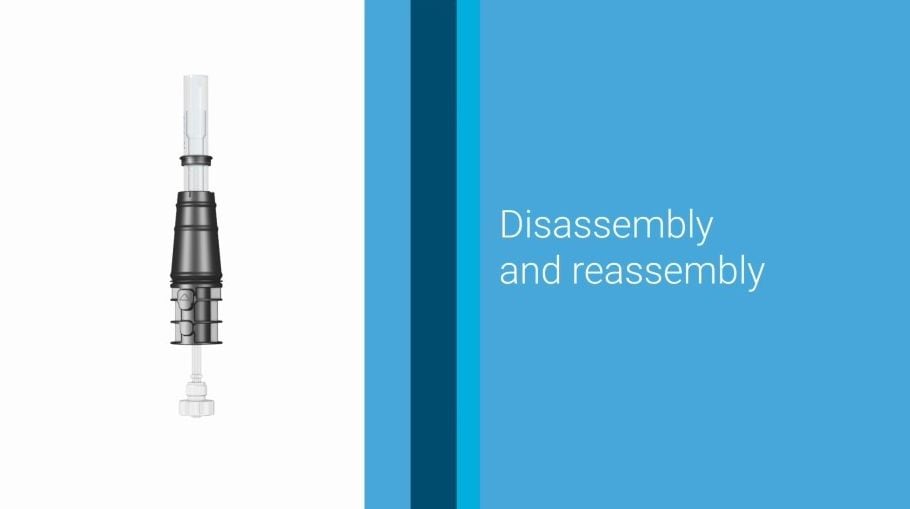ICP-OES Torch Selection Guide

Traditionally, 2 torch configurations have been used with ICP-OES systems, depending on the instrument configuration.
Axially viewed ICP-OES systems typically have a torch that is oriented horizontally and viewed end-on, which offers greater sensitivity.
Radially viewed ICP-OES systems typically have a vertical torch, which is viewed from the side. This is often preferred for complicated high matrix samples and volatile organic solvents because the vertical orientation reduces matrix or carbon build up on the torch, enabling longer analysis time, reduced torch cleaning, and longer torch lifetime.
Today, dual view ICP-OES systems provide the capability for viewing the plasma in both radial (side-on) and axial (end-on) configurations. In some dual-view systems, the torch is oriented horizontally which compromises torch lifetime, and limits the matrix handling capability.
A vertically oriented torch in a dual view instrument ensures uncompromised, robust measurements on tough samples with less cleaning, less downtime, and longer lifetime.
Some torches are also semi- or fully demountable, which can reduce operating costs by enabling the outer tube and/or the injector to be removed and replaced separately.
Each torch has different performance characteristics and although a “standard” torch can handle a wide variety of applications, there are also applications that necessitate a specialized torch design. Using the right ICP-OES torch for your application will ensure you achieve the optimum performance and reduce your risk of injector blockage and unplanned downtime. The performance characteristics of common torches are summarized in the table below:
| Torch Description | Reordering Part Number | Image | Construction | Injector ID (mm) | Tolerance to Dissolved Solids | HF Resistance | Organics Compatibility | Demountable | Ideal Sample Type | Additional Resources |
|---|---|---|---|---|---|---|---|---|---|---|
| Easy-fit one-piece torch (standard torch) | G8010-60228 |  |
Fixed extended outer tube with slot for radial viewing | 1.8 | Medium | Poor | Medium |  |
Routine analysis of aqueous samples with <10% TDS | Learn More |
| Easy-fit demountable torch | G8010-60236 |  |
Replaceable extended outer tube with slot for radial viewing | 1.8 | Medium | Poor | Medium | Semi | Routine analysis of aqueous samples with <10% TDS | Learn More |
| Easy-fit high solids torch | G8010-60232 |  |
Replaceable extended outer tube with slot for radial viewing | 2.4 Tapered | Excellent | Poor | Medium | Semi | High TDS samples with up to 25% TDS | Learn More |
| Easy-fit torch for HF digests | G8010-60231 |  |
Ceramic injector and replaceable extended outer tube with slot for radial viewing | 1.8 | Medium | Excellent | Medium | Semi | Recommended for HF digests | Learn More |
| Easy-fit fully demountable torch | G8020-68005 |  |
Replaceable quartz injector and extended outer tube with slot for radial viewing | 1.8 | Medium | Poor | Medium | Fully | Routine analysis of aqueous samples with <10% TDS | Learn More |
| Easy-fit fully demountable torch for semivolatile organic solvents | G8020-68002 |  |
Replaceable quartz injector and extended outer tube with slot for radial viewing | 1.4 | Medium | Poor | Excellent | Fully | Routine analysis of semivolatile organic solvents. e.g. kerosene, xylene, and white spirit | Learn More |
| Easy-fit fully demountable torch for HF digests | G8020-68003 |  |
Replaceable ceramic injector and extended outer tube with slot for radial viewing | 1.8 | Medium | Excellent | Medium | Fully | Recommended for HF digests | Learn More |
| Easy-fit fully demountable high solids torch | G8020-68004 |  |
Replaceable quartz injector and extended outer tube with slot for radial viewing | 2.4 | Excellent | Poor | Medium | Fully | High TDS samples with up to 25% TDS | Learn More |
| Easy-fit fully demountable torch for Li-battery materials | G8020-68020 |  |
Replaceable ceramic injector and extended organics outer tube with slot for radial viewing | 1.4 | Medium | Excellent | Excellent | Fully | Routine analysis of semi-volatile organic solvents such as kerosene and xylene, samples containing hydrofluoric (HF) acid or Lithium-ion battery materials such as Lithium fluoride or Lithium hexafluorophosphate electrolyte. | |
| Easy-fit fully demountable inert torch for high matrix/high TDS samples | G8020-68022 |  |
Replaceable ceramic injector and extended organics outer tube with slot for radial viewing | 2.4 | Excellent | Excellent | Medium | Fully | HF digests and High TDS samples with up to 25% TDS |
| Torch Description | Reordering Part Number | Image | Construction | Injector ID (mm) | Tolerance to Dissolved Solids | HF Resistance | Organics Compatibility | Demountable | Ideal Sample Type | Additional Resources |
|---|---|---|---|---|---|---|---|---|---|---|
| Easy-fit one-piece torch | G8012-60000 |  |
Fixed shorter outer tube (no slot) for dedicated radial viewing | 1.4 | Medium | Poor | Medium |  |
Routine analysis of aqueous samples with <10% TDS | Learn More |
| Easy-fit demountable torch | G8010-60237 |  |
Replaceable shorter outer tube (no slot) for dedicated radial viewing | 1.4 | Medium | Poor | Medium | Semi | Routine analysis of aqueous samples with <10% TDS | Learn More |
| Easy-fit torch for HF digests | G8010-60234 |  |
Ceramic injector and replaceable shorter outer tube (no slot) for dedicated radial viewing | 1.8 | Medium | Excellent | Medium | Semi | Recommended for HF digests | Learn More |
| Easy-fit fully demountable torch for volatile organic solvents | G8020-68001 |  |
Replaceable quartz injector and shorter outer tube (no slot) for dedicated radial viewing | 0.8 | Poor | Poor | Excellent | Fully | Routine analysis of volatile organic solvents, e.g. gasoline | Learn More |
| Easy-fit fully demountable RV torch for semivolatile organic solvents | G8020-68007 |  |
Replaceable quartz injector and shorter outer tube (no slot) for dedicated radial viewing | 1.4 | Medium | Poor | Excellent | Fully | Routine analysis of semivolatile organic solvents. e.g. kerosene, xylene, and white spirit | Learn More |
| Torch Description | Reordering Part Number | Image | Construction | Injector ID (mm) | Tolerance to Dissolved Solids | HF Resistance | Organics Compatibility | Demountable | Ideal Sample Type | Additional Resources |
|---|---|---|---|---|---|---|---|---|---|---|
| Low-flow (standard torch) | 2010090400 |  |
One piece quartz design | 2.4 | Medium | Poor | Medium |  |
Routine analysis of aqueous samples with <10 % TDS | Learn More |
| Low-flow for volatile organic solvents | 2010104700 |  |
One piece quartz design | 0.8 | Poor | Poor | Excellent |  |
Routine analysis of volatile organic solvents, e.g. gasoline | Learn More |
| Low-flow for semivolatile organic solvents | 2010104800 |  |
One piece quartz design | 1.4 | Medium | Poor | Excellent |  |
Routine analysis of semivolatile organic solvents, e.g. kerosene, xylene, and white spirit | Learn More |
| Low-flow high solids torch | 2010094800 |  |
One piece quartz design with shorter length outer tube and Agilent injector design | 2.4 | Excellent | Poor | Poor |  |
Routine analysis of samples with up to 25 % TDS | Learn More |
| Low-flow, extended length high solids torch | 2010104600 |  |
One piece quartz design with extended length outer tube and Agilent injector design | 2.4 | Excellent | Poor | Poor |  |
Routine analysis of samples with up to 25 % TDS | Learn More |
| Sheath gas high solids torch | 2010122400 |  |
One piece quartz design with extended length outer tube and Agilent injector design | 2.4 | Excellent | Poor | Poor |  |
Routine analysis of samples with up to 25 % TDS with better performance than the extended high solids torch | Learn More |
| Semidemountable inert torch | 9910084700 |  |
Quartz design with removable injector | 0.8 or 1.8 | Medium | Excellent | Medium | Semi | Samples with free HF when used with an inert alumina injector for volatile organic solvents, use narrow 0.8 mm id quartz injector | Learn More |
| Fully demountable torch | 9910106300 |  |
Quartz design with removable injector | 1.8 or 2.4 | Excellent | Excellent | Medium | ✔ | Samples with free HF when used with an inert alumina injector; for aqueous samples, use quartz injector | Learn More |
| Torch Description | Reordering Part Number | Image | Construction | Injector ID (mm) | Tolerance to Dissolved Solids | HF Resistance | Organics Compatibility | Demountable | Ideal Sample Type | Additional Resources |
|---|---|---|---|---|---|---|---|---|---|---|
| Low-flow (standard torch) | 2010069690 |  |
One piece quartz design | 1.8 | Medium | Poor | Medium |  |
Routine analysis of aqueous samples with <10 % TDS | Learn More |
| Low-flow for volatile organics | 2010117400 |  |
One piece quartz design, annealed for greater strength | 0.8 | Poor | Poor | Excellent |  |
Routine analysis of volatile organic solvents, e.g. gasoline | Learn More |
| Low-flow for semivolatile organics | 2010117500 |  |
One piece quartz design, annealed for greater strength | 1.4 | Medium | Poor | Excellent |  |
Routine analysis of semivolatile organic solvents, e.g. kerosene, xylene, and white spirit | Learn More |
| Low-flow high solids torch | 2010095000 |  |
One piece quartz design with Agilent injector design | 1.8 | Excellent | Poor | Poor |  |
Routine analysis of samples with up to 25 % TDS | Learn More |
| Semidemountable inert torch | 9910056800 |  |
Quartz design with removable injector | 0.8 or 1.8 | Medium | Excellent | Medium | Semi | Samples with free HF when used with an inert alumina injector; For volatile organic solvents, use a narrow 0.8 mm id quartz injector | Learn More |
| Fully demountable torch | 9910106400 |  |
Quartz design with removable injector | 1.0, 1.5, 1.8 or 2.4 | Excellent | Excellent | Medium | ✔ | Samples with free HF when used with an inert alumina injector; for aqueous samples, use quartz injector | Learn More |


